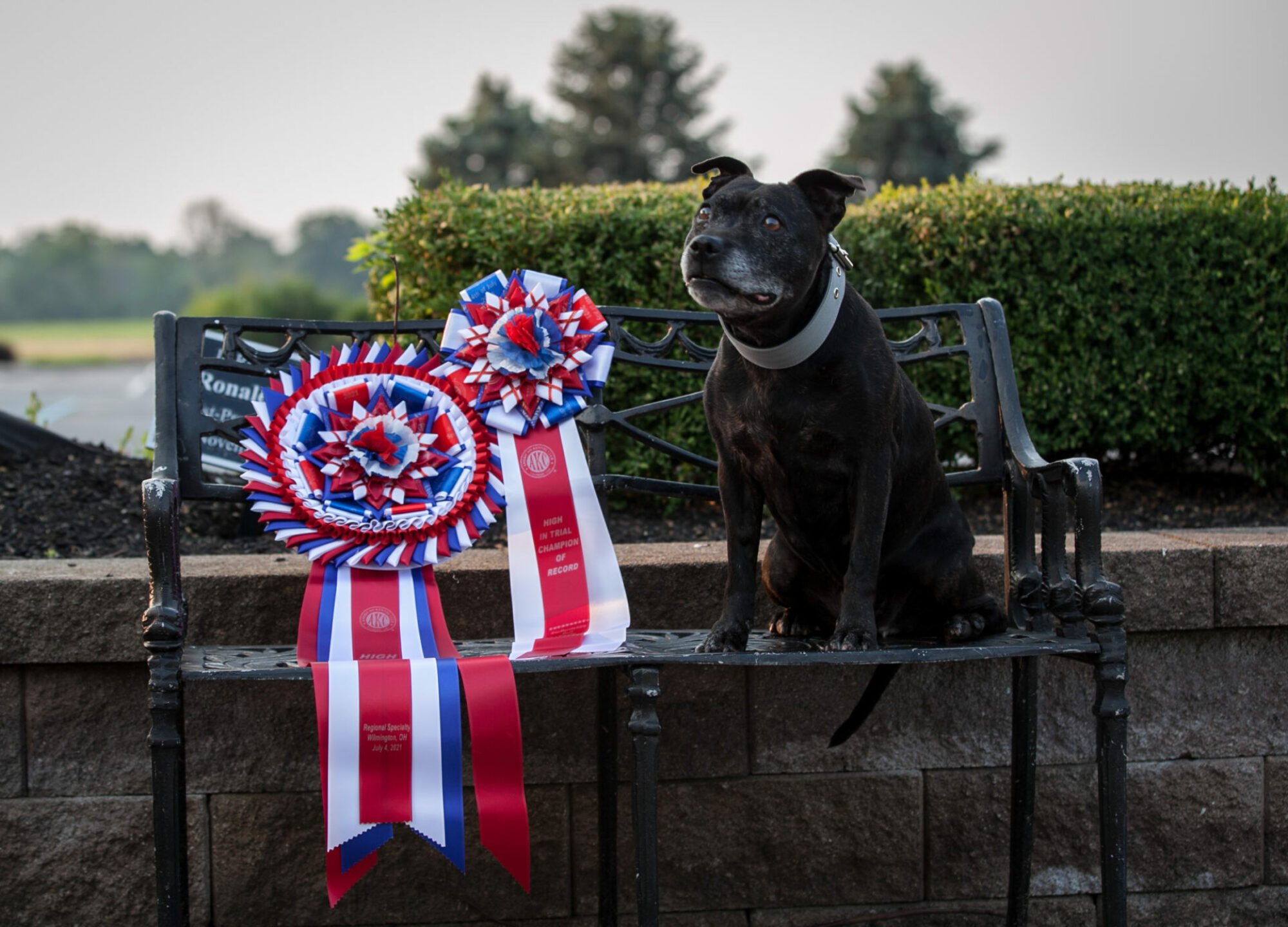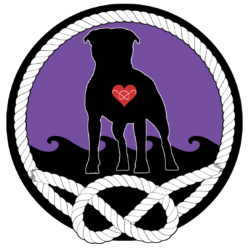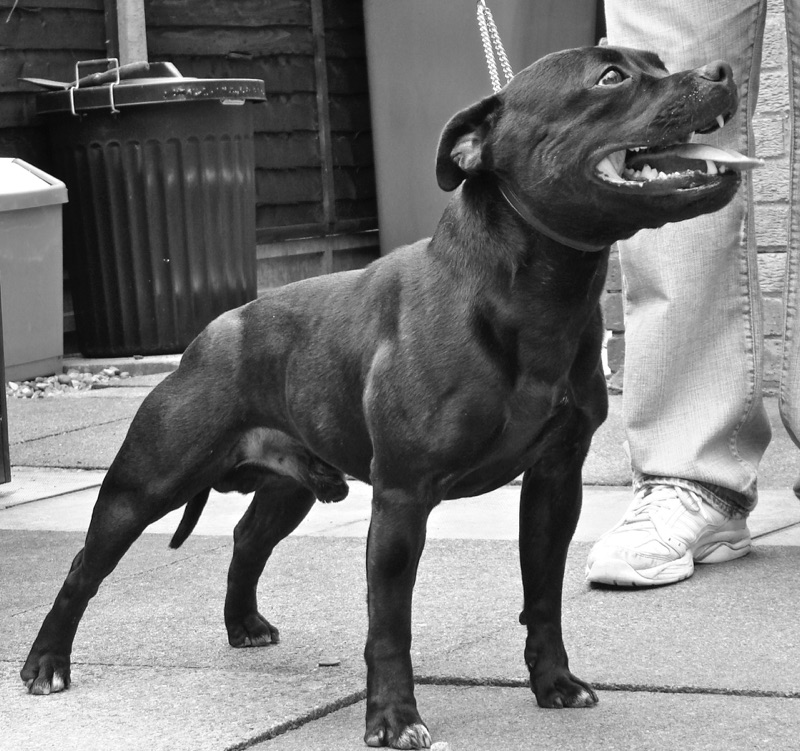If you say to yourself – “What a head!!” then perhaps the head isn’t fitting to the body – taking into consideration of course the age and maturity of the dog, the head and body should fit as one. A Stafford shouldn’t appear to look like a tadpole – a large head on a skinny body. No bobble headed dogs for us thank you! Our male, Captain did appear this way as a puppy and up until he was around 3 years old we always thought his head was just enormous…and it is not a small head measuring almost 19” around. However, now at 3 1/2 years old he stands at just below 16” and weighs 37lbs. He has sufficient rib spring, powerful rear and deep chest. His head no longer is the main focus when you see him. He shows balance.
The head should appear clean as well. No wrinkle or bunched up expression. We like a 2/3 to 1/3 ratio head to muzzle with a definite stop but not an EXAGGERATED stop or lack of stop. The stop itself should be almost vertical. The easiest way to determine accurate stop is to place your thumb on the stop and look at the angle of your thumb. Do not be fooled by the profile view of the eye socket and mistake this for the stop. The lip should be very clean, thin and tight to the teeth meeting top and bottom with no flews or wrinkled, fleshy or spongey excess thus giving the Stafford a somewhat serious expression at times. The lip should not turn down at the end or be excessive. Exaggerations of under jaw include total lack or under jaw, weak under jaw or too strong an under jaw. None of these are correct. Depending upon the cleanness of the lip – this can be difficult to asses without a hands on going over.
The nose itself may turn up slightly at the tip, but keep in mind the plane of the muzzle and the head – they should be parallel to one another. When the muzzle turns up more than the plane of the top skull the dog has a dish face and if the planes dip downward – a down face – neither is clean, balanced and will be exaggerated in expression. When the muzzle is too short or too long they will lack balance. Ears can deceive on a glance so best to get your hands on the dogs head and feel for placement, thickness of leather and size. More on heads in a later article.
Does the dog have sufficient length of leg? Can you see daylight under him/her? If not is it due to a short upper arm or just overall shortness of leg all around? A balanced Stafford should measure the same from the withers to the ground – as it does from the withers to the base of the tail set. Staffords are a square breed. They are not low to the ground or squatty. They are not way up on leg either. Enough leg, enough back – not too much, not too little. Is there massive bone or fine bone? Neither is balanced. Staffords are square – BALANCED with no EXAGGERATION..
Is the animal wider in front than looks natural or is it pinched in front? Neither is correct. The front legs should appear to drop directly down from the shoulder (we will discuss shoulder lay back later). The front shouldn’t appear to be ‘in’ or ‘out’, and MOST CERTAINLY certainly shouldn’t look like a bulldog. The legs straight, no weakness at pastern but the tight well padded feet DO turn out a little. Not a lot, and not straight as in other terrier breeds. (more on feet later as well) The rear should appear strong – not HUGE and not weak and narrow – somewhat even to the front when viewed from above.
There should be a definite waist line with approximately 4 fingers width between the last rib and the hip bone. We like to see that last rib as well, showing no fat or wrinkle and sufficient tuck up from the profile.
A Stafford is certainly well muscled, yet not bunched muscle – long and lean muscle is much more suited to the breed and its original intended purpose. Not a heavyweight boxer but more like a middleweight. It must be able to move easily, be active and agile. Too much bunched muscle is exaggeration and the dog will lack balance. Not enough and he will appear soft and will not function correctly. Exaggeration of muscle in either direction will affect movement as well.
Its all about a balance. NO EXAGGERATION.
When a Stafford is balanced and you do not take special note of any one part over another – then you can determine TYPE more easily. Of course TYPE can be determined in an unbalanced Stafford as well – but for the sake of this article, lets begin with a ring full of balanced animals. I was told that if one were to walk into their ring to judge and turned around to face the exhibits the first thing you would do is determine which entries actually LOOK like a Stafford. That’s a first glance impression of each animal before you. Another way to put it is if the dogs were presented to you in a rescue situation, would you require a second opinion as to whether the dog was a pure breed or a cross breed. Would you know at first glance if the dogs before you were indeed pedigreed Staffordshire Bull Terriers? Do they look like they fit the written breed standard as you interpret it? Do they have that familiar look that determines breed? Its not a black and white answer – but with more experience, seeing and going over more Staffords and interacting with breeders from all over the world you will get a familiar feeling when you see it.
Oftentimes there is a lack of true breed type. There exists some very consistent animals, yet lacking in true type. There is a sort of ‘teddy bear’ quality to them. A generic dog look. Some are quite beautiful to watch and make lovely ‘show dogs’ yet to us – they do not look like Staffords. They have a soft appearance that we cannot explain further than saying they appear cookie cutter generic dog. A Stafford is a clean, balanced, strong, proud, energetic, happy, confident and fit gladiator of a dog. There is a look that to us just screams Staffordshire Bull Terrier. You can’t miss it when you see it.
That is how we define the term TYPE.
Balance & Breed Type
A lot has been said about “Balance” and “Breed Type” but here we will attempt to explain how we interpret these terms as we understand them to mean. We are quite certain our assessments will not be identical to others, however, since this is our website we can only type here what we believe to be true as WE understand the breed to be intended. All that said, if we learn that we are incorrect in our assessment we are quite happy to alter our opinions as such when proven wrong. In order to respect the breed, one must never stop learning and should keep an open mind. This is especially true for breeders as they hold the future of the breed in their hands.


